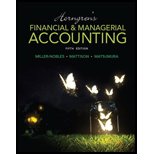
1.
Ethical Issue
Case Summary: The long-term creditors of Company R made conditional agreement that the company cannot purchase
Recently Company R is facing a low demand for the products and its current liabilities grows faster than the current liabilities, resulting in the current ratio become 1.47. The management is worried to work out something before releasing the financial statements. The controller suggested to convert the long-term investments into short-term by choosing to payoff within one year. The board of directors votes for the recommendation of the controller to reclassify the long-term investments to short-term investments.
To Ascertain: The effect of reclassification of investments on the current ratio, and if the financial condition of Company R will be stronger by such re-classification.
2.
To Ascertain: If the managers of Company R have behaved unethically.
Want to see the full answer?
Check out a sample textbook solution
Chapter 15 Solutions
Horngren's Financial & Managerial Accounting (5th Edition)
- Given answer general Accounting questionarrow_forward3 Read the text below. Choose a word that best fits each gap. Summer is a popular time for vacations, and while some people decide to take a , others plan their trip months in advance. The beginning of the year is a good time for people to start looking at holiday Travel agencies and tour operators both ... a wealth of information on vacation... and different types of holidays. Make sure you have all of your travel... before taking any form of international holiday. Check if your passport is... and, if necessary, that you have a visa. As your departure date gets closer, you can start to plan the details of your journey. If you don't know the language well, it might be... to get a phrase book or a ... Some people enjoy doing extensive... on their destinations, learning about the places of interest and "must-sees".... It's also fun to make a list, so you don't ... important clothes or toiletries. It's also a good idea to buy local ... in advance. Make sure your home and pets are ...…arrow_forwardPlease help me with this question general Accounting questionarrow_forward

 Auditing: A Risk Based-Approach (MindTap Course L...AccountingISBN:9781337619455Author:Karla M Johnstone, Audrey A. Gramling, Larry E. RittenbergPublisher:Cengage LearningBusiness/Professional Ethics Directors/Executives...AccountingISBN:9781337485913Author:BROOKSPublisher:Cengage
Auditing: A Risk Based-Approach (MindTap Course L...AccountingISBN:9781337619455Author:Karla M Johnstone, Audrey A. Gramling, Larry E. RittenbergPublisher:Cengage LearningBusiness/Professional Ethics Directors/Executives...AccountingISBN:9781337485913Author:BROOKSPublisher:Cengage- Principles of Accounting Volume 1AccountingISBN:9781947172685Author:OpenStaxPublisher:OpenStax College





